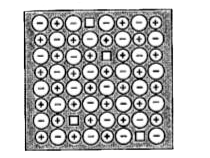Pink colour of LiCl crystals is due to:
Schottky defect
Frenkel defect
Metal excess defect
Metal deficiency defect
To determine the reason for the pink color of LiCl crystals, we need to analyze the defects present in the crystal structure. Here’s a step-by-step solution:
Step 1: Understanding the Composition of LiCl
LiCl is composed of lithium ions (Li⁺) and chloride ions (Cl⁻). The pink color observed in LiCl crystals is related to the behavior of these ions within the crystal lattice.
Hint: Remember that the color in ionic compounds often arises from the presence of defects or the behavior of the ions in the lattice.
Step 2: Identifying the Type of Defect
In the case of LiCl, we need to consider the types of defects that can occur:
- Schottky Defect: Equal numbers of cations and anions leave their lattice sites, creating vacancies.
- Frenkel Defect: A cation leaves its lattice site and occupies an interstitial site, creating a vacancy.
- Metal Excess Defect: Occurs when there are extra cations (Li⁺) in the structure due to the absence of anions (Cl⁻).
- Metal Deficiency Defect: Occurs when there is a deficiency of metal cations in the structure.
Hint: Think about how the absence of certain ions can lead to color changes in crystals.
Step 3: Analyzing the Pink Color
The pink color in LiCl is attributed to the presence of excess lithium ions (Li⁺) due to the absence of some chloride ions (Cl⁻). When Cl⁻ ions leave their lattice positions, it creates vacancies, leading to a situation where there are more Li⁺ ions than Cl⁻ ions, resulting in a metal excess defect.
Hint: Consider how the presence of excess cations can affect the electronic transitions that lead to color.
Step 4: Conclusion
The pink color of LiCl crystals is due to a metal excess defect, where the absence of chloride ions leads to an increase in lithium ions, which in turn causes electronic transitions that produce the observed pink color.
Final Answer: The pink color of LiCl crystals is due to the metal excess defect.
LiCl is composed of lithium ions (Li⁺) and chloride ions (Cl⁻). The pink color observed in LiCl crystals is related to the behavior of these ions within the crystal lattice.
In the case of LiCl, we need to consider the types of defects that can occur:
- Schottky Defect: Equal numbers of cations and anions leave their lattice sites, creating vacancies.
- Frenkel Defect: A cation leaves its lattice site and occupies an interstitial site, creating a vacancy.
- Metal Excess Defect: Occurs when there are extra cations (Li⁺) in the structure due to the absence of anions (Cl⁻).
- Metal Deficiency Defect: Occurs when there is a deficiency of metal cations in the structure.
The pink color in LiCl is attributed to the presence of excess lithium ions (Li⁺) due to the absence of some chloride ions (Cl⁻). When Cl⁻ ions leave their lattice positions, it creates vacancies, leading to a situation where there are more Li⁺ ions than Cl⁻ ions, resulting in a metal excess defect.
The pink color of LiCl crystals is due to a metal excess defect, where the absence of chloride ions leads to an increase in lithium ions, which in turn causes electronic transitions that produce the observed pink color.
Topper's Solved these Questions
- SAMPLE PAPER 2022BOOK - CBSE MODEL PAPERCHAPTER - SAMPLE PAPER 2022EXERCISE - SECTION B
24 Videos
- SAMPLE PAPER 2022BOOK - CBSE MODEL PAPERCHAPTER - SAMPLE PAPER 2022EXERCISE - SECTION C
6 Videos
- QUESTION BANK 2021BOOK - CBSE MODEL PAPERCHAPTER - QUESTION BANK 2021EXERCISE - Multiple Choice Questions
72 Videos
- SAMPLE PAPER 2022 TERM IIBOOK - CBSE MODEL PAPERCHAPTER - SAMPLE PAPER 2022 TERM IIEXERCISE - SECTION-C
5 Videos
Similar Questions
Knowledge Check

In these questions, a statement of Assertion followed by a statement of Reason is given. Choose the correct answer out of the following choices.
Assertion (A): LiCl Crystal is pink.
Reason (R): Pink colour of LiCl crystal is due to excess Lithium.ABoth A and R are true and R is the correct explanation of ABBoth A and R are true but R is NOT the correct explanation of ACA is true but R is falseDA is false and R is TrueThe colour of faecs is brown due to
AurobilinBsterobilinCchlorophyllDBoth (a) and (b)Brown ppt ,of MnO(OH) on boiling with PbO2 and cone HNO3 yields a pink colouration on dilution due to the formation of
AHMnO4BH2MnO4CPb(MnO4)2DPbMnO3
Schottky defect in a crystal arises due to
View SolutionRed or pink colour of central portion of root nodules in legume plants is due to :-
View SolutionThe colour of copper sulphate crystal is
View SolutionThe colour of copper sulphate crystal is
View SolutionPink colour of phenolphthalein in alkaline medium is
View Solution
